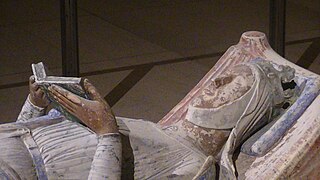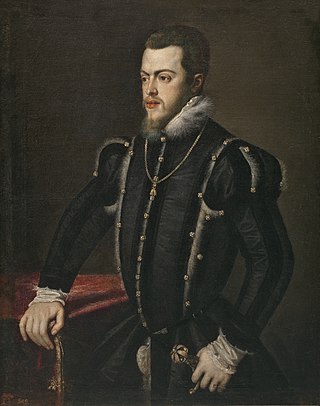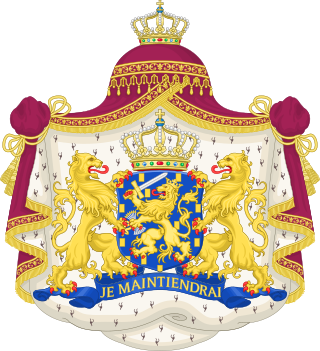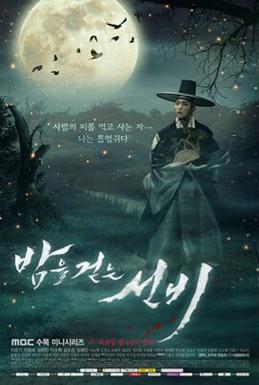
Eleanor was Queen of France from 1137 to 1152 as the wife of King Louis VII, Queen of England from 1154 to 1189 as the wife of King Henry II, and Duchess of Aquitaine in her own right from 1137 until her death in 1204. As the heiress of the House of Poitiers, which controlled much of southwestern France, she was one of the wealthiest and most powerful women in western Europe during the High Middle Ages. She was a patron of poets such as Wace, Benoît de Sainte-Maure, and Bernart de Ventadorn. She was a key leading figure in the unsuccessful Second Crusade.

Philip II, also known as Philip the Prudent, was King of Spain from 1556, King of Portugal from 1580, and King of Naples and Sicily from 1554 until his death in 1598. He was jure uxoris King of England and Ireland from his marriage to Queen Mary I in 1554 until her death in 1558. He was also Duke of Milan from 1540. From 1555, he was Lord of the Seventeen Provinces of the Netherlands.

Albert II is a member of the Belgian royal family who reigned as King of the Belgians from 9 August 1993 to 21 July 2013.

Astrid of Sweden was the Queen of the Belgians and the first wife of King Leopold III. Originally a princess of Sweden of the House of Bernadotte, Astrid became the Duchess of Brabant after her marriage to Leopold in November 1926. She was Queen of the Belgians from 23 February 1934 until her death. Her charity work revolved around women, children, and disadvantaged people.

Alexander was King of Greece from 11 June 1917 until his death three years later, at the age of 27, from the effects of a monkey bite.

Ferdinand I was the King of the Two Sicilies from 1816, after his restoration following victory in the Napoleonic Wars. Before that he had been, since 1759, Ferdinand IV of the Kingdom of Naples and Ferdinand III of the Kingdom of Sicily. He was also King of Gozo. He was deposed twice from the throne of Naples: once by the revolutionary Parthenopean Republic for six months in 1799 and again by Napoleon in 1805, before being restored in 1816.

Prince Laurent of Belgium is the second son and youngest child of King Albert II and Queen Paola, and younger brother of King Philippe. Laurent's involvement with animal welfare and the environment, together with a relative lack of interest in protocol, has caused him to be dubbed by elements of the popular Belgian press as écolo-gaffeur. Currently, he is 13th in the Belgian line of succession. He had been as high as third in line, but the constitution was amended in 1991 to extend an equal right of succession to women, putting him behind his sister, Princess Astrid, and her descendants.

Elisabeth of Romania was a princess of Romania and member of the House of Hohenzollern-Sigmaringen and by marriage Queen of Greece during 1922–1924.

María de las Mercedes, Princess of Asturias was the eldest child of King Alfonso XII of Spain and his second wife, Maria Christina of Austria. She was Princess of Asturias, the heir presumptive to the Crown of Spain, for all 24 years of her life.

Maria Isabella of Spain was an infanta of Spain and queen consort of the Two Sicilies by marriage to Francis I of the Two Sicilies.

The Capetian House of Anjou or House of Anjou-Sicily, was a royal house and cadet branch of the direct French House of Capet, part of the Capetian dynasty. It is one of three separate royal houses referred to as Angevin, meaning "from Anjou" in France. Founded by Charles I of Anjou, the youngest son of Louis VIII of France, the Capetian king first ruled the Kingdom of Sicily during the 13th century. Later the War of the Sicilian Vespers forced him out of the island of Sicily, leaving him with the southern half of the Italian Peninsula — the Kingdom of Naples. The house and its various branches would go on to influence much of the history of Southern and Central Europe during the Middle Ages, until becoming defunct in 1435.
The abele spelen are a collection of four plays contained in the Van Hulthem Manuscript, which dates from 1410 and is in the collection of the Royal Library of Belgium in Brussels.
Gloriant is a Middle Dutch drama. It is one of the four abele spelen contained in the Van Hulthem Manuscript, and consists of 1,142 lines in rhyme. The other abele spelen are Esmoreit, Lanseloet van Denemerken and Vanden Winter ende vanden Somer.

Lanseloet van Denemerken is a Middle Dutch drama. It is one of the four abele spelen contained in the Van Hulthem Manuscript and consists of 925 lines in rhyme.
Vanden Winter ende vanden Somer is a Middle Dutch drama. It is the shortest of the four abele spelen contained in the Van Hulthem Manuscript, comprising 625 lines in rhyme.

The monarchy of the Netherlands is a constitutional monarchy. As such, the role and position of the monarch are governed by the Constitution of the Netherlands. Consequently, a large portion of it is devoted to the monarch. Roughly a third of the document explains the succession, mechanisms of accession & abdication to the throne, and the roles & duties of the monarch. This includes the formalities of communication between the States-General and the monarch's role in creating laws.

Dong Yi is a 2010 South Korean historical television series starring Han Hyo-joo in the title role, along with Ji Jin-hee, Lee So-yeon and Bae Soo-bin. The series centers on the love story between King Sukjong and Choe Suk-bin. It aired from 22 March to 12 October 2010 on MBC TV's Mondays and Tuesdays at 21:55 time slot for 60 episodes.

The Family of Philip V is an oil on canvas painting by the French artist Louis Michel van Loo, completed in 1743. It features life-sized depictions of Philip V of Spain and his family. The painting depicts the royal family in a fictional room and is in the style of French baroque and rococo art. The painting is one of a trio of paintings which bear the same name and are dated 1723 by Jean Ranc, a smaller 1738 version and the 1743 rendition.

The Scholar Who Walks the Night is a 2015 South Korean television series based on the manhwa of the same name written by Jo Joo-hee and illustrated by Han Seung-hee. Starring Lee Joon-gi, Lee Yu-bi, Shim Chang-min, Lee Soo-hyuk, and Kim So-eun, it aired on MBC from July 8 to September 10, 2015 on Wednesdays and Thursdays at 21:55 for 20 episodes.

The Folk of the Air is a young adult fantasy book series by Holly Black, published by Little Brown Books for Young Readers. The story follows the journey of mortal girl Jude Duarte and faerie prince Cardan Greenbriar as they navigate the world of hate, betrayal, and contempt along with feelings for each other. The series is a New York Times Best Seller.
















